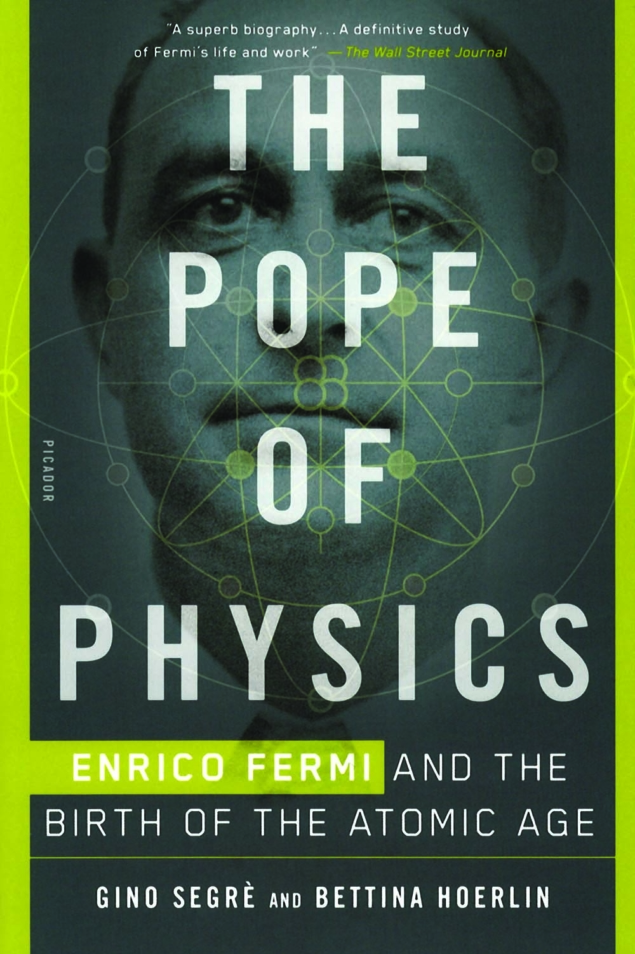By Gino Segrè and Bettina Hoerlin
Henry Holton and Co.

Enrico Fermi can be considered as one of the greatest physicists of all time due to his genius creativity in both theoretical and experimental physics. This book describes his prodigious story, as a man and a scientist.
Born in Rome in 1901, Fermi spent the first part of his life in Italy, where he made his brilliant debut in theoretical physics in 1926 by applying statistical mechanics to atomic physics in a quantum framework, thus sealing the birth of what is now known as Fermi–Dirac statistics. In 1933 he postulated the original theory of weak interactions to explain the mysterious results on nuclear ß decays. Having soon become a theoretical “superstar”, he then switched to experimental nuclear physics, leading a celebrated team of young physicists at the University of Rome, known as the “boys”. Among them were Edoardo Amaldi, Ettore Majorana, Bruno Pontecorvo, Franco Rasetti and Emilio Segrè. They nicknamed him “the Pope” since he knew and understood everything and was considered to be simply infallible. His discoveries on neutron-induced radioactivity and on the neutron slowing-down effect earned him the Nobel Prize in Physics in 1938.
Those were, however, difficult years for Fermi because of Italy’s inconsistent research strategy and harsh political situation of fascism and antisemitism. Fermi left with his family to go to the US in December 1938, using the Nobel ceremony as a chance to travel abroad. Initially at Columbia University, Fermi then moved to the “Met Lab” of the University of Chicago, which was the seed of the Manhattan Project. There, he created the first self-sustained nuclear reactor in December 1942. The breakthrough ushered in the nuclear age, leaving a lasting impact on physics, engineering, medicine and energy – not to mention the development of nuclear weapons. In 1944 Fermi moved to the Manhattan Project’s secret laboratory in Los Alamos. Within this project, he collaborated with some of the world’s top scientists, including Hans Bethe, Niels Bohr, Richard Feynman, John von Neumann, Isidor Rabi, Leo Szilard and Edward Teller. These were terrible times of war.
When the Second World War concluded, Fermi resumed his research activities with energy and enthusiasm. On the experimental front he focused on nuclear physics, particle accelerators and technology, and early computers. On the theoretical front he concentrated on the origin of extreme high-energy cosmic rays. He also campaigned on the peaceful use of nuclear physics. As in Rome, in Chicago he was also the master of a wonderful school of pupils, among whom were several Nobel laureates. Fermi sadly died prematurely in 1954.
This book is about the epic life of Fermi, mostly known to the general public for the first ever nuclear reactor and the Manhattan Project, but to scientists for his theoretical and experimental discoveries – all diverse and crucial in modern physics – which always resulted in major advances. He remains less known as a personality or a public figure, and his scientific legacy is somehow underestimated. The merit of this book is therefore to bring Fermi’s genius within everyone’s reach.
Many renowned texts have been dedicated to Fermi until now, offering various perspectives on his life and his work. First of all on the personal life of Fermi, there is Atoms in the Family (1954) by his widow, Laura. Exhaustive information about Fermi’s outstanding works in physics can be found in the volume Enrico Fermi, Physicist (1970) by his friend and colleague Emilio Segrè, Nobel laureate and Gino Segrè’s uncle, and in Enrico Fermi: Collected Papers, two volumes published in the 1960s by the University of Chicago. Also worth mentioning are: Fermi Remembered (2004), edited by Nobel laureate James W Cronin; Enrico Fermi: His Work and Legacy (2001, then 2004), edited by C Bernardini and L Bonolis, and The Lost Notebook of Enrico Fermi by F Guerra and N Robotti (2015, then 2017), both published by the Italian Physical Society–Springer. Finally, published almost at the same time as Segrè and Hoerlin’s book, is another biography of Fermi: The Last Man Who Knew Everything by D N Schwartz, the son of Nobel laureate Melvin Schwartz. In their “four-handed” book, Segrè and Hoerlin have highlighted with expertise the scientific biography of Fermi and his extraordinary achievements, and described with emotion the human, social and political aspects of his life.
Readers familiar with Fermi’s story will enjoy this book, which is as scientifically sound as a textbook but at the same time bears the gripping character of a novel.







